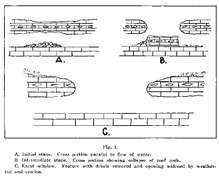Karst fenster
Karst fenster is a geomorphic feature formed from the dissolution of carbonate bedrock. In this feature, a spring emerges, then the discharge abruptly disappears into a sinkhole. The word fenster is German for 'window', as these features are windows into the karst landscape.
The term is used to denote an unroofed portion of a cavern which reveals part of a subterranean river (Easterbrook). A complex underground system of caves, known as karst topography, evolves from the effects of water erosion on carbonate rocks such as limestone, dolomite or gypsum. "A karst fenster is caused by a caving in of portions of the roof of a subterranean stream, thus making some of the underground stream visible from the surface" (Ritter). Theories in the creation of karst topography and karst fensters involve vadose water above the water table, and deep-circulating phreatic water (water in the zone of saturation) eroding away subsurface rock. Karst fensters may also form because of weathering from above.
An example of a karst fenster or window is Cedar Sink in Mammoth Cave National Park, Kentucky, USA.
Wm. von Osinski illustrated how karst windows develop by roof rock collapse.

See also
References
- Easterbrook, Don J. Surface Processes and Landforms. Upper Saddle River, NJ: Prentice-Hall, Inc, 1999
- Ritter, Michael E. The Physical Environment: an Introduction to Physical Geography. 2006. Dec 2009.
- Von Osinski, Wm. "Karst windows." In Proceedings of the Indiana Academy of Science, vol. 44, pp. 161-165. 1934. </ref>